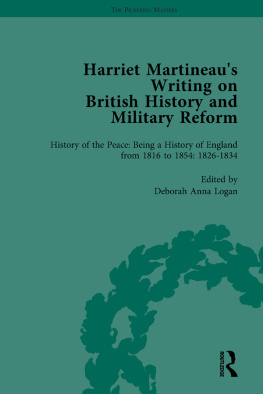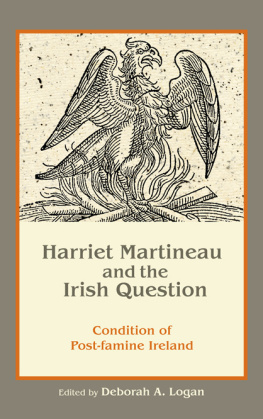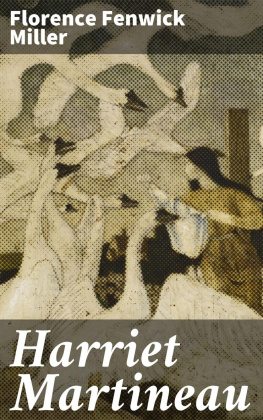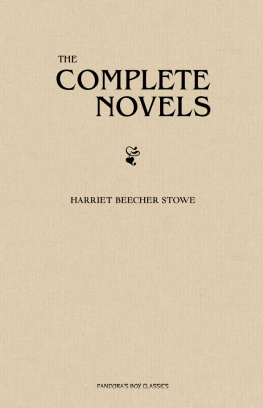First published 2007 by Pickering & Chatto (Publishers) Limited
Published 2016 by Routledge
2 Park Square, Milton Park, Abingdon, Oxon OX14 4RN
52 Vanderbilt Avenue, New York, NY 10017
Routledge is an impront of the Taylor & Francis Group, an informa business
Copyright Taylor & Francis 2007
Copyright Editorial material Deborah Anna Logan 2007
All rights reserved, including those of translation into foreign languages. No part of this book may be reprinted or reproduced or utilised in any form or by any electronic, mechanical, or other means, now known or hereafter invented, including photocopying and recording, or in any information storage or retrieval system, without permission in writing from the publishers.
Notice:
Product or corporate names may be trademarks or registered trademarks, and are used only for identification and explanation without intent to infringe.
BRITISH LIBRARY CATALOGUING IN PUBLICATION DATA
Martineau, Harriet, 18021876
The collected letters of Harriet Martineau. (The Pickering masters)
1. Martineau, Harriet, 1802-1876 - Correspondence
I. Title II. Logan, Deborah Anna, 1951 III. Sanders, Valerie
823.8
ISBN-13: 978-1-85196-804-6 (set)
Typeset by P&C
CONTENTS
- Introduction
- Letters 1837-1845
- Appendix: Martineaus Published Works, 1837-1845

Harriet Martineau. Chalk painting by George Richmond (1849). By permission of National Portrait Gallery, London.
INTRODUCTION
The letters presented in this volume cover the period ranging from July 1837 through January 1845. After arriving from America in late August 1836, Harriet Martineau undertook a round of family visits before returning to her London home at 17 Fludyer Street, Westminster. Besieged by publishing offers, she produced an astounding ten volumes between 1837 and 1839: Society in America, Retrospect of Western Travel and Deerbrook three volumes each and How to Observe Morals and Manners. Add to this an array of periodicals writing including Martyr Age of the United States and her usual vast network of personal and professional correspondence, and this period rivals that of the early 1830s for sheer output.
Several key issues characterize this period of correspondence most notably the erosion of two of Martineaus most important relationships: W. J. Fox and James Martineau. Her letters to Fox following the break with his wife to live with Eliza Flower reveal that her regard and affection for him were undiminished, although she had moved beyond viewing him as her mentor. Martineau respected anyone choosing to live according to conscience, even at the risk of social censure; but she was also deeply distressed by the public spectacle of spouses left behind for a more appealing partner. Far from prudishness, her attitude exhibits a feminist disgust with the sexual double standard, an equation in which redundant women lose, while men who abandon an undesirable wife for another woman remain comparatively unscathed by the scandal. As for the deterioration of her relationship with brother James, the absence of extant letters to him is explained by her edict, issued to all her correspondents, that her letters be destroyed; surviving letters to Helen Higginson Martineau indicate the growing tension between Harriet and the James Martineaus that culminates in a final break in 1851.1
Martineaus 1839 European tour was cut short by the illness that confined her to the sickroom at 12 Front Street, Tynemouth from March 1840 through January 1845. She produced The Hour and the Man, The Playfellow and Life in the Sickroom during this period, while her correspondence was as vigorous as ever; indeed the letters from this period offer an authentic (if unofficial) counterpart to Life in the Sickroom, the official narrative offered for public edification on the cult of invalidism. She received many visitors and participated, primarily through networking, in the pressing social debates of the Hungry 40s: Chartist activism; famine, epidemics and emigration; and Corn Law repeal. Convinced that education would deflect the Chartists threat Forcibly, if we must by appealing to Peacably, if we may, Martineau helped establish libraries for soldiers and workies, she encouraged a national system of education, and she facilitated the institution of cheap periodicals and literary reprints aimed at assuaging the discontent of the masses by providing them with knowledge and information.
Given this formidable legacy in the midst of chronic invalidism, Martineaus enthusiasm for mesmerism seems odd in a woman of such intellectual energy and shrewd judgment; yet, in her defence, after six years confinement in pain and immobility, her release from the sickroom by this simple, non-invasive process offers an irresistible coincidence in timing. In truth, she seems to have begun regaining her health when mesmerism was first tried in June 1844; however close reading of her correspondence throughout the Tynemouth period indicates gradual improvement on her own; her subsequent letters are filled with detailed accounts of her experiences as both a patient and a practitioner of mesmerism.3 Over time her enthusiasm fades; but the episode is a life-altering one that definitively concludes this phase in her life to usher in one marked by physical vigour and spiritual well-being. Martineau left Tynemouth on 13 January 1845 to visit Ambleside, deciding almost immediately to make it her permanent home: and so she did.1
- 1. JM made copies of HMs letters in shorthand before complying with her request to destroy them. The shorthand versions and their translations are at Oxfords Harris-Manchester College, Special Collections. The format of these transcriptions consists of JMs summaries and paraphrases, chiefly of material that concerns himself; direct quotes by HM are rare. JMs resistance to his sister his ridicule of mesmerism offers a case in point is so pronounced that the reliability of his transcriptions is questionable.
- 2. These accounts are prolific and repetitive; editing of them aims to streamline repetitiveness
- 3. There are various significant letters from this period not included in this edition as they are accessible elsewhere. See The Brownings Correspondence, Letters on Mesmerism, Mind amongst the Spindles, Memorials and letters to Jane Carlyle in Valerie Sanders and Deborah Logan (eds), Harriet Martineau Special Edition, Womens Writing, 9:3 (2002), excerpts from which are offered below.
[To Sir William Molesworth]
17 Fludyer St
7 July 1837
My dear Sir












